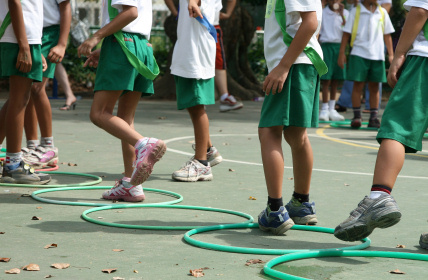
This week we would like to spotlight the Hip Hop Healthy Heart Program for Children™ (Hip Hop), a comprehensive wellness program bringing together physical education, music, and arts in grade K-6th.
The Program Basics
Hip Hop works through wellness education that flows from teacher, to student, to family and the community at large. It requires parents/guardian/mentors to be involved in training on a daily basis, not only helping to reinforce the lessons at home, but also by personally participating in the President’s Active Lifestyle Award Program (PALA). It has 8 multidiciplinary modules and inspires kids to participate by recognizing their achievements with:
- Award certificates for completion of each module
- Certificate of Completion for the entire program.
In order to receive their final program certificate, students and an adult partner are required to register for the PALA when they start Module 1.
Measuring Success
Jyl Steinback, co-creator of the program and Executive Director of Shape Up US mentioned two ways in which Hip Hop is evaluated:
- Educational Assessment: Students are required to complete a written test to assess their comprehension of the topic. Upon passing each module test, students will receive a module certificate of completion and will be eligible for additional awards and prizes.
- Health Assessment: To make sure that the positive lifestyle lessons taught in Hip Hop are truly making a difference, Shape Up US has partnered with HeartSmartKids to track each student’s health progress. Anthropometric data, lifestyle factors, and family history are assessed and tracked using this system.
Challenges
Steinbeck states that, “in some cases, students may not have a parent, guardian or partner/mentor available, or able to participate.” In such cases, she suggests that instructors help students partner with another role model so that they can participate in the program: older siblings; grandparents; recent retiree volunteer – Check www.AARP.org ; student mentor from a local high school as part of the high school’s community service curriculum.
Implementing a Similar Program in Your Community
Use existing infrastructure- The Hip Hop model relies on training educators, healthcare professionals and others who work with groups of children. This creates a program with controlled costs because it builds on existing infrastructure. In your community, try building upon existing infrastructures to implement your program.
Engage parents and guardians- To help engage partners to get the maximum benefit of Hip Hop:
- Letters to send home to parents that provides parents with information about the curriculum prior to starting it
- Parent, guardian or partner/mentor contracts for each module
Reach out to encourage participation-
- Scheduling a group meeting to discuss the curriculum
- Send home personal invitations to the group meeting and ask parent/guardians to RSVP by a specific date.
- Telephone parents who do not respond and encourage them to participate
Don’t forget potential resources in your community- Hip Hop is designed to be taught many different types of teachers. Programs like this can be taught by:
- Public/Private School Teachers as part of their regular curriculum
- Home School Instructors
- PE Instructors
- Fitness Instructors at Health Clubs, After School Programs, YMCA, etc.
- Park and Recreation Instructors

Have you used existing infrastructure to implement a physical activity program? How?